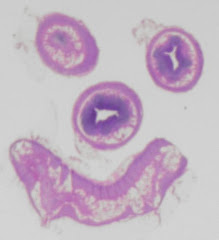To clarify my 2nd-last post, the filling of the Penticton PA position with an experienced PA is not likely to happen in the near future. That leaves two positions: Kelowna (full time) and Vernon (maternity leave x 1 yr or so; beginning no later than April, 2008).
The most recent edition of the CAP Newsletter has a nice, long piece on PAs which, by its length, is rather flattering. Unfortunately, its content, although valuable, is dated in that all of it precedes the AGM in Toronto and does not cover any of the more recent developments. Fortunately, many of you (those who have joined the CAP) have received the e-blast from the PA Section Executive Committee. The problem is that the general membership is unaware of recent achievements, like the formation of the sub-committees, their chairpersons, and their mandates. The pathologists need to be apprised that the PAs are organized and are actively pursuing their mandate (namely, the advancement of standards of excellence of the profession by agreeing upon national key competencies, an accredited curriculum, grand-mother/fathering of practising PAs, the organization of the PA Section's portion of the 2008 AGM, to name but a few). There may be an explanatory comment penned for the next Newsletter.
I was encouraged to learn recently that UBC's PA training programme (MSc) is well on its way to fruition. My hope is that the CMA Accreditation Office will be involved in the process so that this, or a slightly altered, curriculum will be nationally accredited so that PAs can be trained with a standardized curriculum and will be able to work anywhere in the country. This will, I believe, hasten and facilitate the development of provincial regulatory colleges for the profession (or the inclusion of the profession in colleges that already exist).
I have a thorny issue about which to ask your opinion: when considering that which defines a PA, does one take the term literally ("I assist a Pathologist") and thus include all those who do one, but not both, of surgical pathology or autopsy pathology OR does one insist that the only true PA is one who performs all of the duties listed in the key competencies? There are a significant number of individuals who are in one, or the other, category. Are they to be excluded? Does one create more than one category of PA? Or does one accept all comers? If so, how does one create guidelines and maintain standards?
As you know, the nation's pathologists (or at least those belonging to the CAP) are in the process of arriving at workload guidelines for pathologists; hopefully by the end of the year. The guidelines will consider whether the facility is an academic one or not. Will they also consider whether or not PAs are employed? They should (and I have not heard that they will). If they do not, they will discount the valuable aspect of the process of generating a surgical (or autopsy) pathology report which is provided by PAs and, of course, will potentially over-value the remainder. Pathologists practising at those institutions which do not have PAs will be the first to tell you how important the Gross Description is to the final report. Those who are assisted by PAs may take for granted this aspect of the report, much as the valuable technical work preformed by Medical Laboratory Technologists might be assumed to be a 'given.' PAs have been in existence for so long; a significant number of pathologists who have done their residencies and all of their practices to date with PAs have been conditioned to believe that PAs are part of the system and will naturally feel that their (the pathologists') workload (and salary) 'assumes' the existence of PAs. It should be no different for facilities that do not have PAs. That is, the expectation of the pathologist to sign-out cases who also has to do the Gross, should be upwards of 1/3 less than for the pathologist who has the assistance of a PA. PAs should do whatever they can to ensure that the CAP's pathologists include the PAs' portion of the day-to-day work in a pathology department in their deliberations on this subject. You are no doubt aware that Cytotechnologists are limited to a maximum number of slides that they are expected to view each day and, in fact, each hour. Beyond this number, the thinking goes, the quality of the output decreases (that is, the chance of error increases). The same principle ought to exist for PAs; they should be expected to examine only a certain number of surgical specimens within any day, or hour. The L4E workload system works very well in quantifying the workload of pathologists. It can work equally well for PAs, proportionately. If a PA, performing gross descriptions on surgical pathology specimens, is doing about 1/3 of the work of a pathologist, it will be an easy task to calculate the maximum allowable workload of a PA. Beyond the maximum, it will be assumed that the quality of the work is in jeopardy. This amount, once quantified, should be included in the guidelines and key competencies for PAs; presently being considered by the CAP, the PA Section of the CAP and the CMA Accreditation Office.
More on this subject later...
Sunday, October 21, 2007
Subscribe to:
Post Comments (Atom)



No comments:
Post a Comment